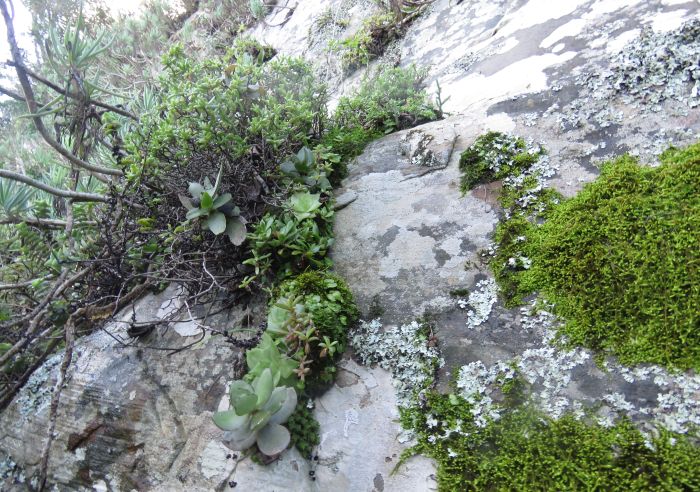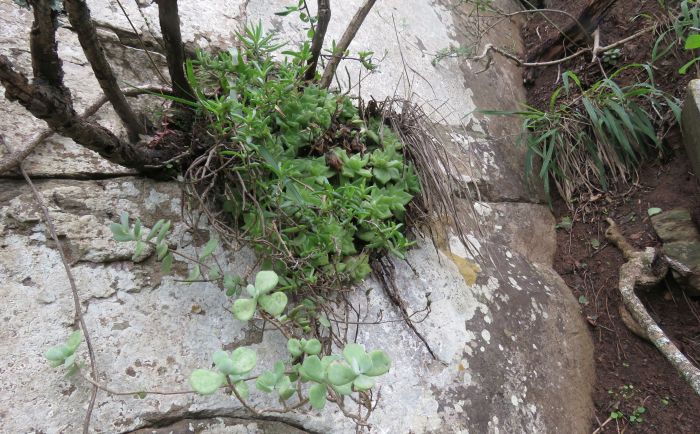Haworthia cymbiformis var. ramosa
Haworthia cymbiformis (Haw.) Duval var. ramosa (G.G.Sm.) M.B.Bayer
Family: Asphodelaceae
Common names: Keiskamma haworthia (Eng.); Keiskamma-dwergaalwyntjie (Afr.)
Introduction
Haworthia cymbiformis var. ramosa is a dwarf, cliff-hugger, with numerous small rosettes of light green, triangular-lanceolate, succulent leaves and a solitary inflorescence of white flowers in spring and early summer. It grows on cliffs along the Keiskamma River in the Eastern Cape. Best grown in containers.

Fig. 1. A clonotype of Haworthia cymbiformis var. ramosa, the plant collected by G.G. Smith (G.G. Smith 3168) on the farm Wooldridge.
Description
Description
Plants dwarf-sized, neatly rosulate, prolific from the base, forming small to large, rounded clusters up to 300 mm in diameter, consisting of more than 25 heads. Rosettes 40–130 mm in diameter, bearing leafy branches up to 150 mm long; branches grey, up to 7 mm in diameter. Roots grey, terete, up to 4 mm in diameter. Leaves up to 25, soft, broadly ovate to oblanceolate, amplexicaul at base and partly imbricate, patent with spreading to incurved translucent and striate apices; upper side flat to channelled or slightly convex, lower side cymbiform; surface smooth, green, becoming pinkish green to yellowish during dry periods; margin entire or with soft teeth; apex acute to acuminate, mucronate. Inflorescence racemose, up to 250 mm long, 10–20-flowered in distal half; bracts white, clasping, up to 3 mm long, ovate-acuminate; pedicels 2 mm long. Perianth tubular, curved, ascending-spreading, 15 mm long, white with purplish green midstripe. Capsule 5 × 2 mm. Seed 2.5 × 1.5 mm. Flowering is mainly from spring to early summer (October–November). Seeds are dispersed by wind in summer and early autumn.

Fig. 2. A cluster of a clonotype of the Haworthia cymbiformis var. ramosa, the plant collected by G.G. Smith (G.G. Smith 3168) on the farm Wooldridge. Note the leafy stem which distinguishes this variety from other varieties of H. cymbiformis.
Conservation Status
Status
Confined to cliffs along the Keiskamma River in the Eastern Cape. It is mostly well protected by its difficult to reach, sheer cliff-face habitat and its distribution falls within a greater conservation region. Consequently it was not taken up in the Red List of South African Plants.

Fig. 3. A cliff face at Wooldridge, habitat of Haworthia cymbiformis var. ramosa, and a young cluster of Haworthia cymbiformis var. ramosa on the cliff, sharing its habitat with Delosperma stenandrum, Crassula orbicularis and Albuca bracteata (pregnant onions).
Distribution and habitat
Distribution description
Haworthia cymbiformis var. ramosa is only known from the Keiskamma River, near the farm Wooldridge, in the Peddie District, Eastern Cape and further downstream, growing on cliffs at an altitude of between 200–500 m. It grows on adjacent cliffs, on all aspects, but more so on shady, south-facing aspects. Plants are rooted in crevices and their size often depends on the growing space allowed by the crevice. Temperatures are high in summer (28–40°C). Winters are cooler but frost is absent. Rainfall occurs throughout the year but with a peak in spring and summer, ranging from 250–400 mm per annum in the form of thunder showers or cyclonic winter rain.

Fig. 4. Haworthia cymbiformis var. ramosa growing on a cliff south of Wooldridge, sharing sharing its habitat with Curio ficoides, Delosperma stenandrum and the dwarf geophyte, Crassula nemorosa.
The associated vegetation is Great Fish Thicket of the Thicket Biome (Mucina et al. 2006). Associated cliff-dwellers include: Bulbine keiskammaensis, Crassula cordata, C. intermedia, C. muscosa, C. perfoliata var. minor and C. spathulata, Ornithogalum longibracteatum and Plectranthus verticillatus.
The geology consists of sandstone and mudstone cliffs, Adelaide Subgroup of the Karoo Supergroup. The cliff substrate has many ledges, crevices and fissures, ideal for the establishment of plants.

Fig. 5. Haworthia cymbiformis var. ramosa sharing its cliff habitat with Curio ficoides, Crassula lactea, C. cultrata, C. perforata, C. socialis and C. nemorosa, Delosperma laxipetalum and D. stenandrum and Coleus madagascariensis.
Derivation of name and historical aspects
History
Haworthia cymbiformis was named by Adrian Haworth (1768–1833) as Aloe cymbiformis in Transactions of the Linnaean Society in 1804. Duval in 1809 transferred Haworth’s species to his newly named genus Haworthia in 1809, in his Plantae succulentae, in Horto Alenconio. The species name cymbiformis, meaning ‘boat-shaped’, pertains to the shape of its leaves.
This distinctive form of Haworthia cymbiformis was named Haworthia ramosa by G.G. Smith in the Journal of South African Botany in 1944, from plants discovered by him at Wooldridge in 1940. Haworthia expert Bruce Bayer, former Curator of the Karoo National Botanical Garden, realised it is part of the H. cymbiformis complex and reduced the species ramosa to varietal status in 1976. The varietal name ramosa, meaning ‘branched’, pertains to its freely branching nature.

Fig. 6. A shady cliff face on the Keiskamma River, habitat of Haworthia cymbiformis var. ramosa, here it is growing with Cotyledon woodii, Delosperma laxipetalum, Crassula cordata, Albuca bracteata and Curio ficoides.
Haworthia cymbiformis is a very variable complex and the 6 varieties recognised reflect this variability. The var. ramosa is distinguished from the other varieties of H. cymbiformis by its short, leafy stems. However, as Bayer (1999) stated, the plants are variable and some populations do not have stems, such as those found by the author, who explored further down the Keiskamma in a rubber canoe in 2019, where plants were found with large, open rosettes (see Figs 4–8). Related to H. cooperi and H. retusa, both usually plants from hilly terrain and well-camouflaged, and often occurring under the protection of thorny nurse shrubs; their leaves generally have a firmer texture. The other varieties of H. cymbiformis include: var. cymbiformis, var. obtusa, var. reddii, var. incurvula, var. setulifera and var. transiens. Of these varieties, the var. reddii, var. transiens and var. setulifera also grow mainly on cliffs.
Ecology
Ecology
The plants grow in conspicuous, globose clusters, often with short, flaccid, leafy stems, suggesting an adaptation to maximise light absorption in its shady environment.

Fig. 7. The shady cliff face at the Keiskamma River, habitat of Haworthia cymbiformis var. ramosa. Note the large clusters, at least 30 cm in diameter, plastered on the sheer cliff.
The leaves are very fleshy, soft, often spreading as an adaptation to regulate excessive absorption of light. The leaves are amplexicaul (with no stalk and the base of the leaf surrounding the stem) and partly imbricate (overlapping like roof tiles), the arrangement minimising water loss and exposure to excessive radiation on the exposed cliff faces.
The leaves become yellowish to pinkish during dry periods, as the plants aestivate, blocking out excessive light and reducing photosynthesis. Plants are long-lived, with leaves withering from the base. The leaves become turgid after rain, but are channelled during dry periods, an adaptation to dry periods experienced in its habitat. Compared to related plants, there is a reduction in camouflage, in response to its undisturbed cliff habitat, and in contrast to the thorny but heavily grazed surrounding thicket vegetation.
The inflorescence is ascending to spreading, the corolla white, attracting the right pollinating flying insect. The light and angular seeds are shaken from the capsules and dispersed by wind. They are small, ideal for establishment in crevices. Seeds ripen in summer and autumn, coinciding with the rainy season. Germination occurs within 14–21 days.
Haworthia cymbiformis var. ramosa suckers freely from the base, forming dense, rounded clusters. Continual sprouting from the base represents an efficient vegetative backup dispersal strategy for this harsh cliff-face environment. Detached clusters or heads will also root if they fall into a crevice.

Fig. 8. South facing cliff faces along the Keiskamma River, the habitat of Haworthia cymbiformis var. ramosa.
Uses
Use
No uses have been recorded.
Growing Haworthia cymbiformis var. ramosa
Grow
This is an adaptable plant, suitable for thicket and subtropical coastal gardens (Van Jaarsveld 2010) but best for shady, rocky embankments. Plants are fairly fast-growing and respond well to watering and feeding, soon filling a container. Water can be given throughout the year, but sparingly in winter.
Haworthia cymbiformis var. ramosa is easily propagated from seed or division. It performs at its best when grown as a pot plant, in partial shade and kept in small containers or miniature succulent gardens, simulating the small crevices of the cliff environment. The soil should be sandy and slightly acid, with ample feeding throughout the year. Outside its habitat, it is best grown under controlled conditions in a greenhouse.
In its habitat at Wooldridge along the Keiskamma River in the Eastern Cape district, rain falls mainly during spring, summer and autumn, although some rain falls in winter. It is thus best to water well during summer and less so during the winter. The plants are frost-sensitive and should be protected the winter where frost can be a problem. The young plants start solitary, soon dividing to form small, dense clusters.
The soil should be sandy and well-drained, as is found in its natural habitat. They will react to any fertiliser but organic fertilisers are best, such as well broken-down compost. As a pot plant, it is best on a balcony or windowsill.
Plants can be divided any time of the year, but better in spring. Plant in a shallow tray in a sandy mixture (such as a mixture of peat, sand and polystyrene) and kept moist. Rooting is within 3 weeks and once well rooted transfer to individual containers. Place container in a shady position but with full light. The south side of a building is ideal.
Sow seed in spring, summer or autumn in a sandy medium. First moisten the substrate with a fine rose. Cover the seed lightly with a thin layer of sand. Keep moist and in a shady position. Germination is usually within 3 weeks and the young seedlings grow relatively fast. Transplant seedlings to individual containers when they are large enough to handle.
Plants are relatively disease free but aphids, slugs and snails can sometimes be a problem.
References
- Bayer, M.B. 1999. Haworthia revisited, a revision of the genus. Umdaus Press, Hatfield.
- Duval, H.A. 1809. Plantae succulentae, in Horto Alenconio. Paris.
- Haworth, A.H. 1826. Description of new succulent plants. Philosophical Magazine 57: 92.
- Haworth, A. H. 1804. A new arrangement of the genus Aloe. Transactions of the Linnaean Society 7: 11.
- Haworth, A. H. 1812. Synopsis Plantarum Succulentarum. London.
- Mucina, L. & Rutherford, M.C. (eds) 2006. The vegetation of South Africa, Lesotho and Swaziland. Strelitzia 19. South African National Biodiversity Institute, Pretoria.
- Scott, C.L. 1985. The genus Haworthia, a taxonomic revision. Aloe Books, Johannesburg.
- Smith, G.G. 1944. Some new species and varieties in the genus Haworthia: Journal of South African Botany 10: 22.
- Van Jaarsveld, E.J. 2010. Waterwise gardening in South Africa and Namibia. Struik, Cape Town.
Credits
Ernst van Jaarsveld
Kirstenbosch National Botanical Garden (Retired 2015)
Babylonstoren Farm
Extraordinary senior lecturer and researcher,
Department of Biodiversity and Conservation, University of the Western Cape
August 2021
Plant Attributes:
Plant Type: Succulent
SA Distribution: Eastern Cape
Soil type: Sandy
Flowering season: Spring, Early Summer
PH: Acid, Neutral
Flower colour: White
Aspect: Morning Sun (Semi Shade), Afternoon Sun (Semi Shade)
Gardening skill: Easy
Special Features:
Horticultural zones







Rate this article
Article well written and informative
Rate this plant
Is this an interesting plant?
Login to add your Comment
Back to topNot registered yet? Click here to register.